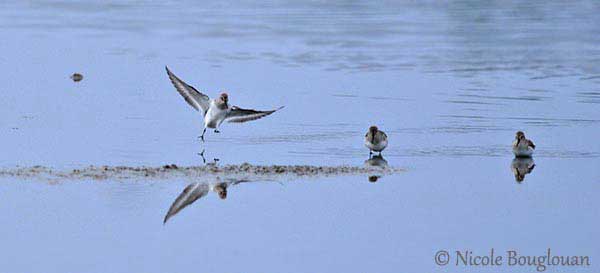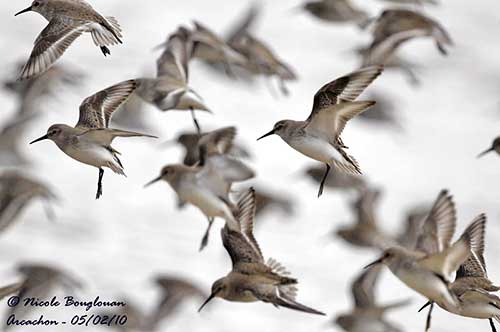
Fr: Bécasseau variable
Ang: Dunlin
All: Alpenstrandläufer
Esp: Correlimos Común
Ita: Piovanello pancianera
Nd: Bonte Strandloper
Sd: Kärrsnäppa
Photographers:
John Anderson
John Anderson Photo Galleries
José Luis Beamonte
Pájaros de España
Tom Grey
Tom Grey's Bird Pictures
Ingo Waschkies
My bird pictures on Pbase
Nicole Bouglouan
PHOTOGRAPHIC RAMBLE
Text by Nicole Bouglouan
Sources:
HANDBOOK OF THE BIRDS OF THE WORLD Vol 3 by Josep del Hoyo-Andrew Elliott-Jordi Sargatal - Lynx Edicions - ISBN : 8487334202
SHOREBIRDS by Peter Hayman, John Marchant and Tony Prater – Christopher Helm – 1986 – ISBN: 0747014035
THE COMPLETE BOOK OF BRITISH BIRDS – Written by “Royal Society for the Protection of Birds” experts - Préface de Magnus Magnusson - Michael Cady- Rob Hume Editors - ISBN: 0749509112
THE HANDBOOK OF BIRD IDENTIFICATION FOR EUROPE AND THE WESTERN PALEARCTIC by Mark Beaman, Steve Madge - C. Helm - ISBN: 0713639601
GUIDE DES LIMICOLES de D. Taylor - Delachaux et Niestlé - ISBN : 2603014080
All About Birds (Cornell Lab of Ornithology)
Pájaros de España (JL Beamonte)
Bird Web (Seattle Audubon Society)
Department of Sustainability, Environment, Water, Population and Communities
Dunlin
Calidris alpina
Charadriiformes Order – Scolopacidae Family
INTRODUCTION:
The Dunlin is a circumpolar breeder. It breeds far North in the Arctic and winters southwards in more temperate regions. This species is common, but the overall population trend is decreasing, due to the usual threats including habitat loss on the breeding grounds, nest predation by introduced mammals on some islands, disturbances, pollution…
The Dunlin has currently ten subspecies, but some of them are still uncertain. This species is gregarious outside breeding, and they often gather in huge flocks. If they are disturbed, they all fly off together, turning and flying in unison.

DESCRIPTION OF THE BIRD:
Biometrics:
Length: 16-22 cm
Wingspan: 33-40 cm
Weight: 33-85 g
The Dunlin in breeding plumage has rufous upperparts with blackish, white, greyish and chestnut markings. Mantle, scapulars and tertials are blackish with variable chestnut, grey or whitish fringes. The wing-coverts are grey-brown with pale grey to whitish fringes. The flight feathers are blackish-brown, whereas sides of rump and uppertail are white, and sides of tail are greyish-brown.
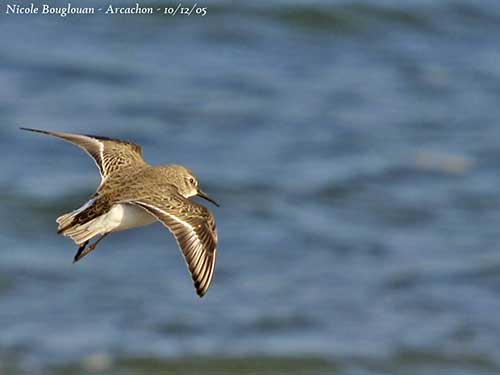
On the underparts, the chin is white, but the foreneck is whitish and slightly streaked dark brown, becoming more conspicuous on the breast. We can see a large, black patch bordered with white on centre of belly. Vent, undertail, underwing and axillaries are white.
On the head, the crown is streaked brown and chestnut, and we can see a white supercilium. The lores are dusky and the ear-coverts are pale and slightly streaked. Nape and hindneck are greyish or brownish with brown streaks.
The bill is black and downcurved towards the tip, with much variation in length. The eyes are dark brown. Legs and feet are blackish.
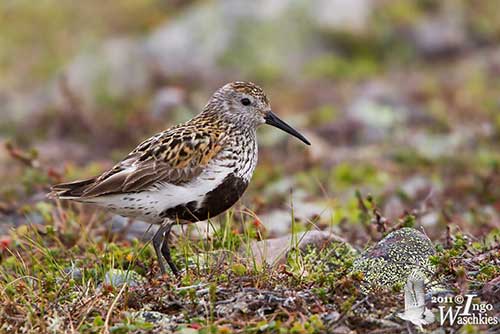
The adult in non-breeding plumage has dull grey-brown crown and ear-coverts, hindneck, mantle, scapulars and wing-coverts. The supercilium is whitish. The underparts are white, but the breast sides are slightly streaked grey-brown.
Male and female have similar plumage, but the female is larger and longer-billed than male.

The juvenile has pale buff, streaked breast. Several rows of prominent blackish spots are visible on flanks and sides of the white belly. Lores and ear-coverts are warm brown.
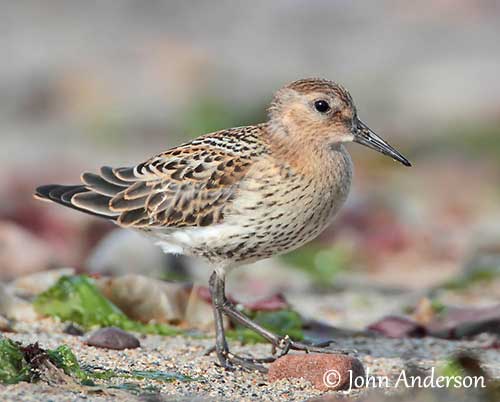
SUBSPECIES AND RANGE:
The Dunlin breeds in the Arctic or subarctic regions. The breeders of N Europe and Asia winter south to Africa, S Asia and Middle East. The breeders of Alaska and Canadian Arctic migrate to Pacific and Atlantic coasts of North America. The breeders of N Alaska winter in Asia.
There are ten recognized subspecies which differ in size and bill length, intensity of plumage colour and more or less large black patch on belly.
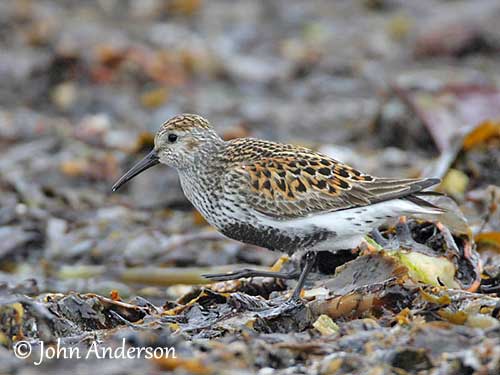
Races arcticola, pacifica and hudsonia breed in Alaska and Canada. The race arcticola winters in E China, Korea and Japan, whereas pacifica and hudsonia winter along the coasts of USA, respectively W and E coasts. These races have more rufous upperparts.

Races arctica, schinzii, alpina and centralis breed from NE Greenland to NE Siberia, and winter in NW Africa (arctica), S Europe and NW Africa (schinzii), from W Europe and Mediterranean to NW India (alpina) and E Mediterranean and Red Sea E to S Asia (centralis).
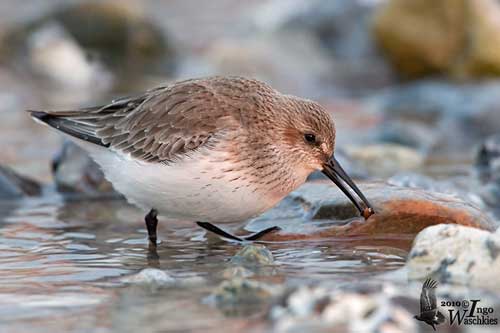
Races sakhalina, actites and kistchinski breed in extreme E Siberia S to Kuril Islands, and winter in E China, Korea and Japan, with small numbers in W North America.
HABITAT:
The Dunlin breeds in a wide variety of habitats including boggy tundra, moorland often close to pools, wet coastal grassland and salt marshes, tussock tundra and peat-hummock in Arctic.
After breeding, it frequents tidal mudflats, freshwater lakes, brackish lagoons, sandy beaches and flooded fields, and also estuarine mudflats.

CALLS AND SONGS: SOUNDS BY XENO-CANTO
The Dunlin gives a shrill, rasping “kreeep” in flight. While feeding in flocks, they produce a low “beep” and a soft twittering at roost.
On the breeding grounds, it utters prolonged, reedy, descending trilled whistles while displaying. When alarmed, it produces a sharp “quoi” and a low “wurt-wurt-wurt”.
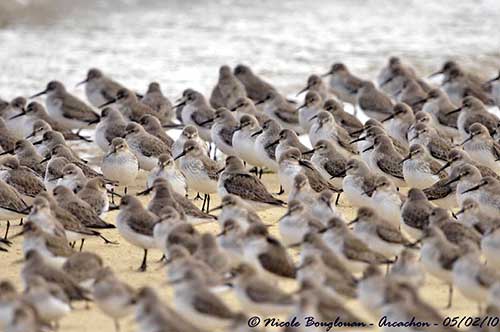
BEHAVIOUR IN THE WILD:
The Dunlin feeds by walking or running, while picking rapidly at the surface. It is sometimes called the “sewing machine” because it bobs the head up and down and pokes into the ground with the bill while feeding.
It forages in open mud near the water’s edge, and wades in shallow water.
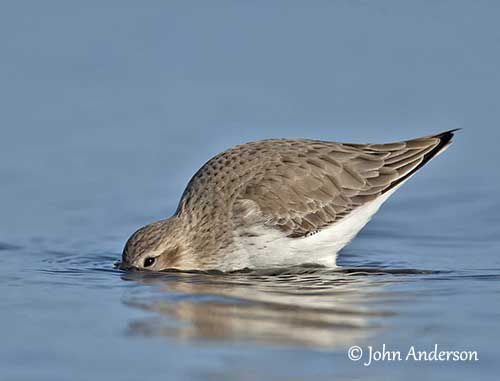
Its diet includes various insects, especially adults and larvae of Dipterans, spiders, earthworms, snails and plant material. Outside the breeding season, it takes mostly worms and small gastropods, but insects, crustaceans, bivalves, some small fish and plant matter are also taken. It rejects the fragments of shells by regurgitation. It feeds by day but also at night.
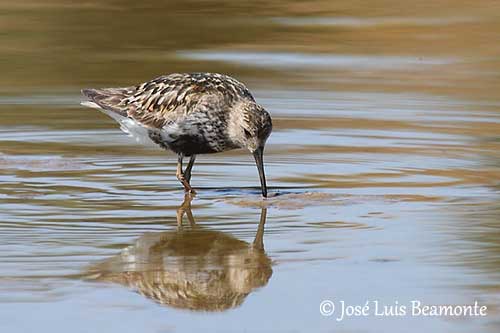

Dunlins often form huge flocks and the birds can be seen flying together, performing coordinated aerial manoeuvres with rapid changes of direction to flash their white underparts.
During the breeding season, they perform a low display flight with quivering wingbeats interspersed with glides. They circle slowly over the breeding territory. They are monogamous and solitary nesters, with usually 3-30 birds/km².
In front of a rival or an intruder, the Dunlin reacts by advancing, then pausing to raise one wing vertically high over back.
The Dunlin is migratory and performs short coastal flights to long, non-stop flights overland in broad front. They moult in large concentrations on or near the wintering areas. Some immature birds may spend all the year in the non-breeding range, but most of them return to the breeding grounds.
The Dunlin has rapid, low flight when flushed. Larger flocks twist and turn in unison while flying together.
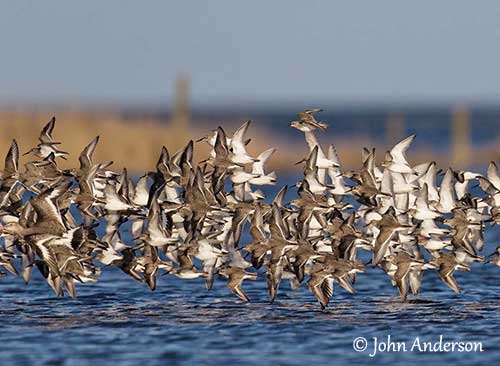
REPRODUCTION OF THIS SPECIES:
The Dunlin nests between late April and August, with the laying in June-July in the Arctic, and late April to May in the southern parts of the breeding range.
It nests on the ground in sparse, low vegetation, usually hidden in or under a clump of grass. The birds make a shallow scrape with a lining of leaves and grass. Usually, the male prepares several scrapes with lining, and the female chooses one as the nest and finishes to build it.
The female lays 4 pale olive eggs with dark brown markings, making them very cryptic on the ground. Both adults share the incubation during 20-22 days, and they tend the brood together. The chicks leave the nest very soon after hatching and depend on parents until they fledge, about 19-20 days after hatching. They start to breed at one year or more.
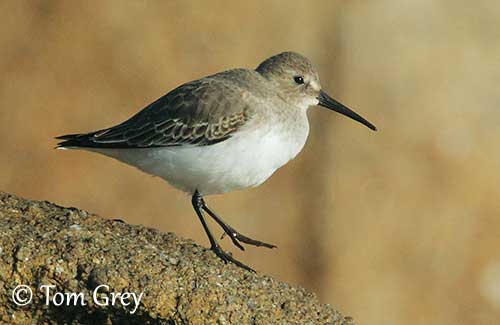
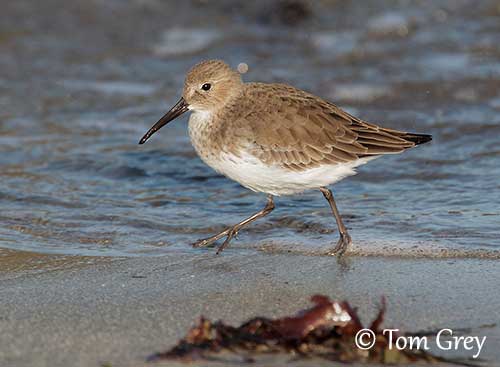
PROTECTION / THREATS / STATUS:
The Dunlin has large range. It is threatened by habitat loss in its breeding grounds, and drainage of wetlands involving changes in estuaries where it often spends the winter.
Nest predation by introduced mammals on some islands is a problem too.
Some important migratory stopovers on the Baltic Sea coastline are threatened by petroleum pollution and various changes in the habitat.
The global population is estimated to number 4,600,000/6,500,000 individuals (Wetlands International 2006). The overall population trend is decreasing, but some races such as arctica and shinzii are considered stable.
The Dunlin is currently evaluated as Least Concern.
